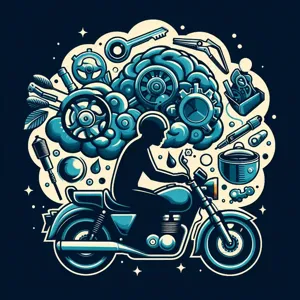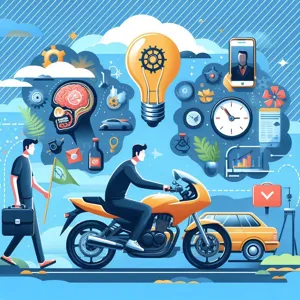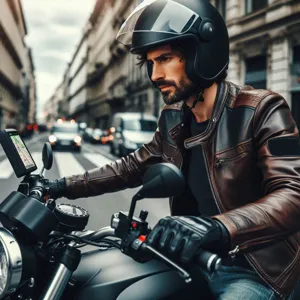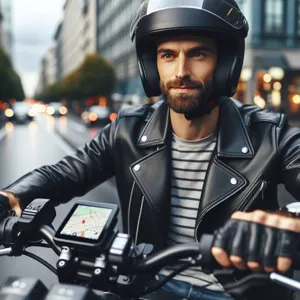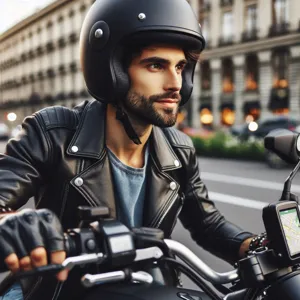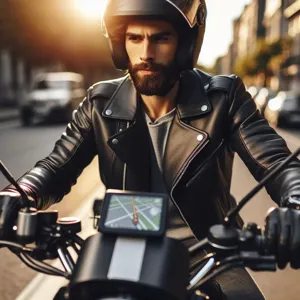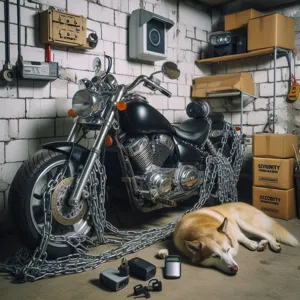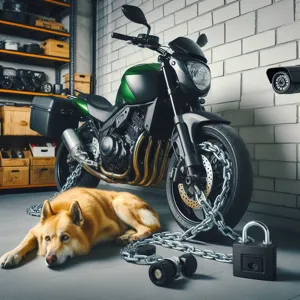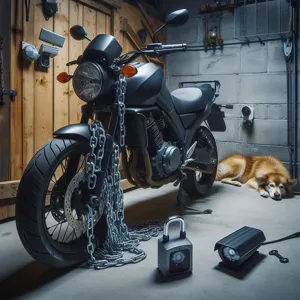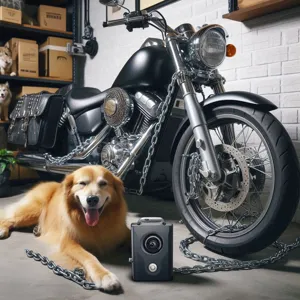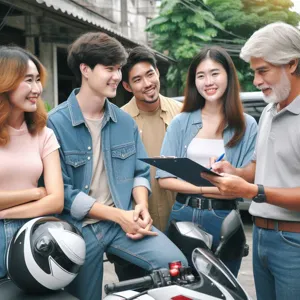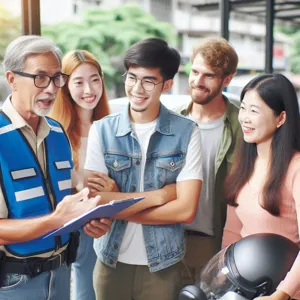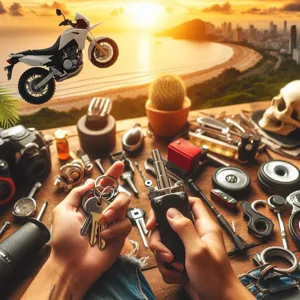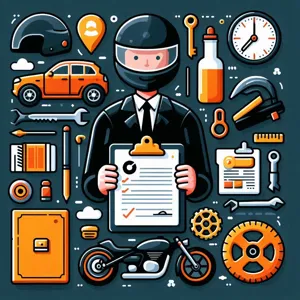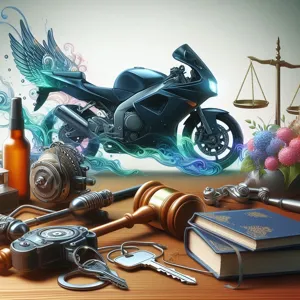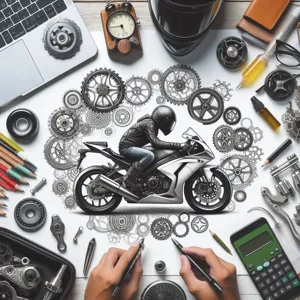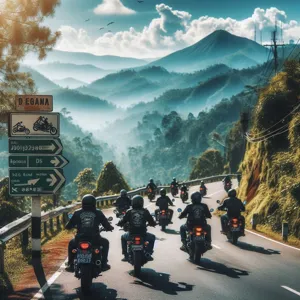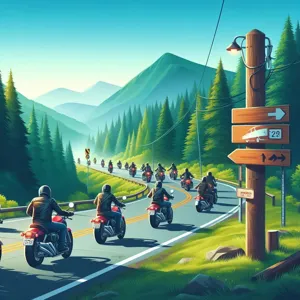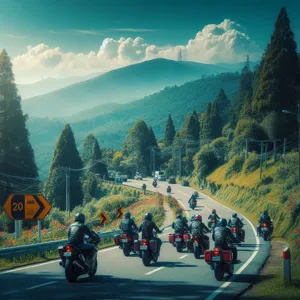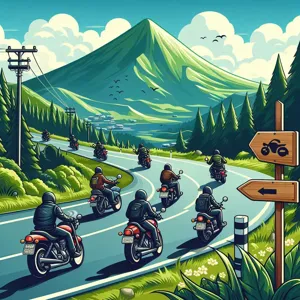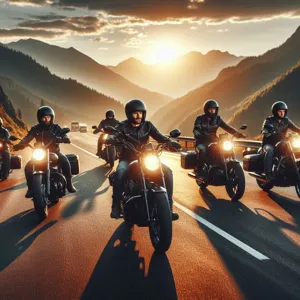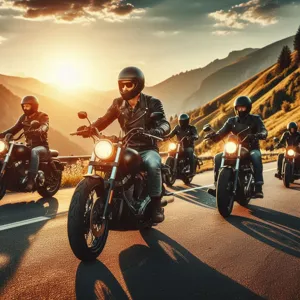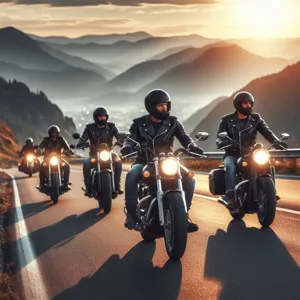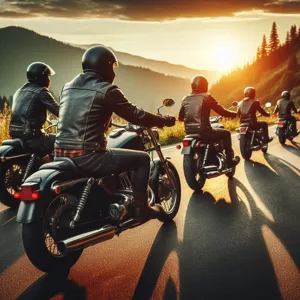The roar of an engine, the rush of the wind, and the exhilarating sense of freedom that comes with riding a motorbike is a dream for many, yet the fear of falling or losing control can hold aspiring riders back.
If you’ve ever found yourself captivated by the allure of the open road but paralyzed by anxiety at the thought of hopping on that two-wheeled beast, you’re not alone. Overcoming a fear of riding can feel like an intimidating challenge, but with the right mindset and practical strategies, you can transform that fear into unshakeable confidence. In this blog post, we’ll explore effective techniques to conquer your apprehensions, share inspiring stories from seasoned riders who once felt the same way, and offer tips to help you ease into the thrill of the ride. So gear up and get ready to rev up your confidence as we embark on this journey to embrace the exhilarating world of motorbiking!
1. Understanding the Fear: Common Concerns About Riding

Understanding the fear of riding a motorbike is the first step toward overcoming it. For many aspiring riders, the prospect of hopping on a two-wheeled machine can be fraught with anxiety. Common concerns often revolve around safety, control, and the sheer power of the vehicle. The open road, while exhilarating, can seem intimidating when you consider the traffic, weather conditions, and potential hazards.
Many people worry about losing balance or making a wrong turn, which can lead to dangerous situations. The fear of falling is particularly prevalent; even seasoned riders have felt that familiar knot in their stomach when faced with the thought of an unexpected spill. Furthermore, the potential for accidents, often highlighted in media narratives, can loom large in the minds of those who are new to riding.
In addition to physical concerns, there’s the psychological aspect of self-doubt. Thoughts of inadequacy can creep in, leading to the belief that riding requires a level of skill far beyond one’s current capabilities. The worry of not being able to react quickly enough in emergencies can create an overwhelming sense of apprehension.
It’s important to remember that these fears are normal and shared by many. Acknowledging these concerns is key; they don’t signify weakness but rather a natural human response to venturing into the unknown. By taking the time to understand the roots of these fears, you can begin to address them head-on, paving the way for a more confident riding experience. With the right mindset, training, and preparation, you can transform that fear into a thrill, opening the door to endless adventures on the open road.
2. The Benefits of Riding a Motorbike
Riding a motorbike is more than just a mode of transportation; it’s an exhilarating experience that offers a plethora of benefits that can help rev up your confidence on the road and in life. For starters, the sheer thrill of the ride is unmatched. The wind in your hair, the rumble of the engine, and the feeling of freedom as you navigate through winding roads create an adrenaline rush that few other activities can replicate. This sense of liberation can significantly boost your mood and invigorate your spirit, making you feel more alive and connected to your surroundings.
Beyond the thrill, riding a motorbike promotes a unique sense of independence. Unlike driving a car, where you are enclosed and somewhat isolated, a motorcycle allows you to engage directly with the environment. You become more attuned to your surroundings, enhancing your awareness and observational skills. This heightened focus not only increases your safety as a rider but also fosters a sense of empowerment—each ride becomes a testament to your capability and control.
Additionally, motorcycling can be a fantastic way to build community. Joining local riding clubs or participating in group rides fosters camaraderie among fellow enthusiasts, providing a support system that can help ease your fears. Sharing experiences, tips, and advice with other riders can inspire you to push your boundaries and embrace new challenges, gradually transforming apprehension into enthusiasm.
Moreover, riding a motorbike can be a practical and economical choice. With better fuel efficiency compared to cars, you can save money while enjoying the open road. This financial aspect can also contribute to your confidence, knowing that you’re making a smart choice for both your wallet and your well-being.
Lastly, the discipline and skills you develop as a motorbike rider carry over into other aspects of life. The focus, patience, and quick decision-making required to navigate traffic and manage your bike translate into enhanced confidence in everyday situations. By facing and overcoming the initial fears of riding, you not only conquer the road but also build resilience that empowers you in various challenges life presents.
In essence, the benefits of riding a motorbike extend far beyond the thrill of the ride. It’s an opportunity for personal growth, community connection, and practical advantages that together create a compelling case for embracing this empowering journey. So, gear up and get ready to unlock a world of confidence, adventure, and freedom that awaits you on two wheels!
3. Mental Preparation: Visualizing Success on Two Wheels

Before you even mount the bike, mental preparation plays a crucial role in overcoming your fear of riding. Visualization is a powerful tool that can help reshape your mindset and build the confidence you need to embrace the open road. Take a moment to find a quiet space, close your eyes, and vividly imagine yourself riding with ease, grace, and control. Picture the sensation of the wind against your skin, the roar of the engine under you, and the thrill of navigating through turns with confidence.
As you visualize, focus on the details: the gleaming handlebars in your grip, the feel of the throttle responding to your every command, and the smooth motion of the bike as it glides along your chosen route. Imagine yourself handling various scenarios—cruising through busy streets, making sharp turns, and confidently stopping at intersections. The more specific your visualization, the more real it becomes in your mind, which helps to reduce anxiety and increase your sense of capability.
Incorporate positive affirmations into your practice. Repeat phrases like “I am in control,” “I am a skilled rider,” and “I enjoy the freedom of riding” to reinforce a positive self-image. This mental rehearsal not only prepares you for the physical act of riding but also conditions your mind to expect success rather than failure. Remember, riding is as much about mental strength as it is about physical skill. By envisioning yourself as a confident, competent rider, you’ll find that your fears will begin to dissipate, making way for the exhilarating experience that riding a motorbike can offer.
4. Choosing the Right Bike for Beginners
Choosing the right bike for beginners is a crucial step in overcoming your fear of riding and building the confidence you need to hit the open road. With countless options available, it can be overwhelming, but understanding the key features that cater to novice riders will simplify the process.
First and foremost, consider the bike’s size and weight. Opt for a motorcycle that you can comfortably handle. A lighter bike will allow for easier maneuverability, helping you feel more in control, especially at low speeds. Look for models with a seat height that allows you to plant both feet firmly on the ground when stopped—this grounding effect can significantly boost your confidence during your first rides.
Next, evaluate the engine size. As a beginner, it’s wise to start with a smaller displacement engine, typically between 250cc and 500cc. These bikes offer enough power to provide an exhilarating experience without overwhelming you with excessive speed or torque. Many manufacturers offer models specifically designed for new riders, featuring a more forgiving throttle response and smoother acceleration to help ease you into the learning curve.
Also, pay attention to the bike’s riding style. Sportbike enthusiasts may be drawn to the sleek designs and performance, but these bikes often require advanced handling skills. Instead, consider a standard or cruiser motorcycle, which typically offers a more upright seating position and a relaxed riding style, making it easier to navigate city streets and winding roads alike.
Finally, don’t underestimate the importance of aesthetics. Choose a bike that resonates with your personal style—whether it’s classic, modern, or adventurous. Feeling good about the bike you’re riding can enhance your overall experience and make it easier to embrace the journey ahead.
Take your time during this process. Visit local dealerships, test ride various models, and seek advice from experienced riders. By selecting the right bike, you’re not just investing in a vehicle; you’re investing in your confidence and creating a solid foundation for a lifelong passion for motorcycling.
5. Essential Gear for Safety and Confidence
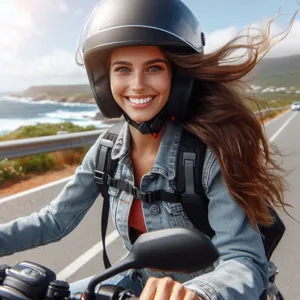
When it comes to conquering your fear of riding a motorbike, investing in the right gear is paramount—not just for safety, but for building confidence on the road. The right equipment not only protects you in the event of an accident but also enhances your riding experience, making you feel more secure and in control.
Start with a high-quality helmet, which is your first line of defense. Look for a full-face helmet that meets safety standards, providing comprehensive coverage and protection. A snug fit is crucial, as it ensures the helmet stays securely in place during your rides. Choose one with ventilation to keep you cool, and opt for a design that resonates with your personal style—after all, feeling good in your gear can significantly boost your confidence.
Next, consider investing in protective clothing. A sturdy, abrasion-resistant jacket and pants made from materials like leather or reinforced textiles can shield your skin from road rash in case of a fall. Look for features like armor at the elbows, shoulders, and knees for added protection, and ensure the clothing fits comfortably to allow for free movement. Layering is also a good approach; it helps you adapt to varying weather conditions while keeping you safe.
Footwear is another critical element of your gear. Choose boots that cover your ankles and are designed specifically for riding. They should provide grip and stability while offering protection against impacts. Avoid sneakers or casual shoes that lack the necessary support and durability.
Finally, don’t overlook the importance of gloves. A good pair of riding gloves not only protects your hands but also enhances your grip on the handlebars. Look for gloves that offer a balance of comfort, dexterity, and protection, with padding on the knuckles and palms to absorb shocks.
Together, this essential gear forms a protective barrier that allows you to ride with greater peace of mind. Knowing that you are well-equipped can help diminish fear, empowering you to embrace the thrill of motorbike riding with renewed confidence. So, gear up, hit the road, and let the adventure unfold!
6. Taking a Motorcycle Safety Course
Taking a motorcycle safety course is one of the most effective ways to build your confidence and diminish your fear of riding. These courses are designed not only to teach you the practical skills needed to operate a motorcycle safely but also to instill a sense of assurance in your abilities as a rider.
In a structured environment, you’ll have the opportunity to learn from seasoned instructors who are well-versed in the intricacies of motorcycle operation and safety protocols. They will guide you through everything from basic handling techniques to advanced maneuvers, all while emphasizing safety and risk awareness. The hands-on training allows you to familiarize yourself with the controls and dynamics of a motorcycle, turning what once felt intimidating into a manageable, even enjoyable experience.
Moreover, participating in a safety course offers a unique chance to connect with fellow aspiring riders. Sharing fears, tips, and personal experiences with others can be incredibly empowering. You’ll quickly discover that you are not alone in your apprehensions; many of your classmates are navigating similar emotions as they take this exciting step toward freedom on two wheels.
Finally, completing a motorcycle safety course often comes with additional benefits, such as reduced insurance premiums or even the confidence to pursue your motorcycle license sooner. As you master the essential skills and knowledge, the road ahead will not only feel more accessible but also exhilarating. With each lesson learned, your confidence will steadily increase, transforming fear into a passion for riding that you never thought possible.
7. Practice Makes Perfect: Starting with the Basics
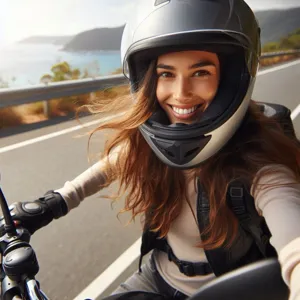
When it comes to conquering your fear of riding a motorbike, there’s no substitute for practice, and starting with the basics is crucial. Just like mastering any new skill, riding a motorbike requires a solid foundation. Begin your journey by familiarizing yourself with the bike itself. Spend some time sitting on it while it’s stationary, getting a feel for its weight, controls, and balance. This simple act can help demystify the machine and make it feel more like an extension of yourself rather than an intimidating piece of equipment.
Once you feel comfortable, progress to practicing in a safe, controlled environment. Look for empty parking lots or quiet streets where you can ride without the pressure of traffic. Here, you can focus on essential skills such as starting, stopping, turning, and shifting gears. Take your time; there’s no rush. Focus on each maneuver, gradually increasing your confidence as you become more adept.
As you gain comfort with the basics, consider enrolling in a motorcycle safety course. These structured programs not only teach you essential riding techniques but also provide invaluable feedback from experienced instructors. They create a supportive environment where you can learn at your own pace, surrounded by fellow beginners who share your apprehensions and aspirations.
Remember, the key to overcoming fear is repetition. The more you practice, the more confident you will become. Celebrate small victories along the way, whether it’s successfully navigating a turn or mastering a smooth stop. With each practice session, you’ll find that your fear diminishes, replaced by a growing sense of control and exhilaration. So gear up, take a deep breath, and embrace the journey of becoming a confident motorbike rider—one basic skill at a time.
8. Building Skills: Maneuvering and Handling Techniques
Building skills in maneuvering and handling techniques is essential for any aspiring motorbike rider. Mastering these skills not only enhances your confidence on the road but also ensures your safety and the safety of those around you. Start by familiarizing yourself with the basic controls of your bike—understanding how to operate the throttle, brakes, and clutch will provide you with a solid foundation for more advanced techniques.
Once you’re comfortable with the controls, practice low-speed maneuvers in a controlled environment, such as an empty parking lot. This is where you’ll refine your balance and coordination. Focus on practicing tight turns, figure eights, and slow-speed stops. These exercises will help you develop a keen sense of your bike’s dimensions and weight distribution, crucial elements when navigating through traffic or tackling winding roads.
Next, incorporate emergency handling techniques into your practice regime. Learning how to perform emergency stops, swerving to avoid obstacles, and controlling your bike in adverse conditions can drastically reduce the risk of accidents. Enrolling in a motorcycle safety course can provide you with expert guidance and valuable feedback as you hone these skills.
Don’t forget about the importance of body positioning. Knowing how to shift your weight for turns and how to maintain a relaxed grip on the handlebars will greatly improve your control. Remember, each time you practice, you’re not just honing your riding skills; you’re also building your confidence.
As you progress, gradually challenge yourself with different environments—practice riding on varied terrains and in diverse weather conditions. This exposure will help you become a versatile rider, ready to tackle any situation that comes your way. By consistently working on your maneuvering and handling techniques, you’ll find that the fear of riding will diminish, making way for a newfound sense of freedom and excitement on two wheels.
9. Gradual Exposure: Overcoming Fear Through Experience
Conquering the fear of riding a motorbike isn’t about jumping into the deep end right away; it’s about easing into the experience, allowing your confidence to build gradually. This concept, known as gradual exposure, is a time-tested technique that encourages you to face your fears step by step, mitigating anxiety while enriching your understanding of motorcycle riding.
Start by familiarizing yourself with the bike. Spend time sitting on it, feeling its weight and balance, and getting comfortable with the controls. This initial phase is crucial as it helps create a sense of ownership and familiarity. Once you feel secure, take the bike for a gentle ride in a safe, controlled environment—think empty parking lots or quiet back roads. Here, you can practice starting, stopping, turning, and accelerating without the pressure of traffic or distractions.
As your comfort level grows, increase the complexity of your rides. Gradually introduce yourself to busier roads and varied terrains. Each small challenge you conquer will bolster your confidence, transforming the intimidating into the manageable. Remember, it’s perfectly acceptable to go at your own pace; there’s no need to rush the process.
Additionally, consider joining a motorcycle training course or riding group. Learning alongside others who share similar fears can provide encouragement and camaraderie, making the experience far less daunting. Not only will you gain valuable skills and tips from more experienced riders, but you’ll also find reassurance in the shared journey of overcoming fear.
Ultimately, the key to overcoming your fear of riding is patience and persistence. By allowing yourself to gradually acclimate to the experience, you will foster a deeper connection with both the bike and the open road, paving the way for a fulfilling and exhilarating riding journey.
10. Riding with Friends: The Support System
Riding with friends can transform the experience of motorcycling from a solitary venture into a communal adventure filled with camaraderie and support. When you’re navigating the winding country roads or cruising through city streets, having fellow riders by your side can significantly bolster your confidence. Friends who share your passion for biking not only provide a sense of security but also create a vibrant atmosphere that makes every ride more enjoyable.
Picture this: a group of you revving your engines, feeling the excitement build as you prepare to hit the open road. The laughter and banter as you gear up create a shared energy, igniting your enthusiasm and dissipating any lingering fears. You have a built-in support system ready to encourage you through those moments of uncertainty. Whether it’s someone reminding you to relax your grip on the handlebars or encouraging you to take on that tricky turn, their presence can be invaluable.
Moreover, riding with friends allows for an exchange of knowledge and skills. Experienced riders can offer tips and tricks that can help you hone your technique, from mastering cornering to improving your braking. They can also share their own experiences of overcoming fears, which can be incredibly motivating. This shared wisdom fosters a sense of community and belonging, making it easier to confront the challenges of riding.
Don’t forget about the added layer of safety that comes with a group. In the unfortunate event of a mishap, having friends around ensures that support is readily available. Knowing that you’re not alone can ease the anxiety that often accompanies the thought of riding, especially for beginners.
So, gather your riding buddies and make a plan for your next adventure. Whether it’s a scenic weekend getaway or just a quick jaunt around town, the joy of riding alongside friends can significantly diminish your fears and amplify your confidence. Remember, the road is always more enjoyable when traveled together.
11. Dealing with Setbacks and Challenges
Setbacks and challenges are an inevitable part of the journey to becoming a confident motorbike rider. Whether it’s a minor mishap during practice or a more significant obstacle, learning how to navigate these hurdles is crucial to building your resilience and enhancing your riding skills.
First and foremost, it’s essential to embrace setbacks as learning opportunities rather than as failures. Every rider, no matter how experienced, has faced their share of difficulties. Perhaps you dropped your bike during a slow-speed maneuver or struggled with mastering a particular technique. Instead of letting these moments discourage you, take the time to analyze what went wrong and how you can improve. This reflective practice can turn a frustrating experience into a valuable lesson, sharpening your skills and boosting your confidence.
Additionally, it’s important to remember that progress is rarely linear. You may have days where everything clicks and riding feels effortless, while other days might seem filled with challenges. During those tougher moments, remind yourself of the progress you’ve already made. Celebrate small victories—like successfully navigating a tricky corner or improving your balance—because they lay the foundation for greater achievements.
Surrounding yourself with a supportive community can also make a world of difference. Seek out local riding groups or forums where you can share your experiences, seek advice, and gain encouragement from fellow riders who understand the journey. Hearing about their challenges and how they overcame them can inspire you to persevere through your own setbacks.
Finally, don’t shy away from seeking professional guidance. Consider enrolling in advanced riding courses or workshops that focus on specific skills you wish to master. A fresh perspective and expert advice can provide the clarity and confidence you need to tackle challenges head-on.
In the world of motorcycling, every setback is a stepping stone toward becoming a more skilled and confident rider. By embracing challenges, reflecting on your progress, leaning on your community, and seeking guidance, you’ll find that each obstacle only makes your passion for riding stronger. So rev up your engines, face those challenges, and keep pushing forward on the exhilarating road ahead!
12. Staying Calm: Techniques for Managing Anxiety
When it comes to overcoming the fear of riding a motorbike, mastering the art of staying calm is essential. Anxiety can be a formidable barrier, often manifesting as racing thoughts, shallow breathing, or a feeling of being overwhelmed. However, with the right techniques, you can transform that anxiety into confidence and clarity.
One effective method is practicing deep breathing exercises. Before you even mount your bike, take a moment to inhale deeply through your nose, allowing your abdomen to expand fully. Hold for a count of three, then exhale slowly through your mouth. This simple act not only calms your nervous system but also helps you regain focus and control, preparing you for the ride ahead.
Visualization techniques can also play a crucial role in managing anxiety. Before hitting the road, close your eyes and picture yourself riding smoothly, confidently navigating curves, and enjoying the freedom of the open road. Imagine the sensations—the wind against your face, the roar of the engine, and the thrill of maneuvering through traffic. By creating a mental image of success, you reinforce positive feelings and reduce the likelihood of panic.
Additionally, grounding techniques can help anchor you in the moment. When you start feeling anxious, focus on your surroundings. Notice the colors of the trees, the texture of the pavement, or the sound of the engine. By directing your attention outward, you divert your mind from anxious thoughts and bring yourself back to the present.
Finally, consider incorporating mindfulness into your pre-ride routine. Spend a few minutes in quiet reflection, acknowledging your fears without judgment. Accept that it’s okay to feel anxious; it’s a natural response. By recognizing and accepting your emotions, you empower yourself to move beyond them.
With practice, these techniques can help you cultivate a sense of calm that accompanies each ride, turning your anxiety into excitement and paving the way for a more confident motorcycling experience. Remember, every seasoned rider started where you are now, and with patience and perseverance, you too can rev up your confidence and embrace the thrill of the ride.
13. Celebrating Small Wins: Tracking Your Progress
Celebrating small wins is an essential strategy in overcoming your fear of riding a motorbike. It’s easy to focus solely on the bigger goal—the exhilarating moment of cruising down the open road with the wind in your hair—but it’s the incremental achievements that truly pave the way to confidence. Every small step you take in your riding journey deserves recognition, as these victories collectively contribute to overcoming your fears.
Begin by setting manageable milestones for yourself. Perhaps it’s successfully balancing your bike while stationary, mastering the art of starting and stopping smoothly, or even just feeling comfortable in your gear. Each of these milestones is a testament to your growing skills and resilience. Keep a journal to document these achievements, noting how you felt during each ride, what you learned, and the challenges you overcame. This not only serves as a motivational tool but also allows you to reflect on your journey and recognize how far you’ve come.
Don’t hesitate to indulge in a little celebration after reaching a milestone. Whether it’s treating yourself to a nice meal, sharing your success with friends or fellow riders, or simply taking a moment to acknowledge your progress, these small celebrations reinforce positive feelings associated with riding. They remind you that every bit of progress counts and that overcoming fear is a journey filled with triumphs, no matter how small.
Tracking your progress and celebrating those small wins transforms the daunting experience of learning to ride into a more enjoyable and fulfilling adventure. With each victory, you’ll find yourself more confident, gradually silencing the fears that once held you back and embracing the joy of motorcycling with open arms. So, keep riding, keep tracking, and above all, keep celebrating every step of the way!
14. Maintaining a Positive Mindset: Affirmations and Motivation
Maintaining a positive mindset is crucial when it comes to overcoming the fear of riding a motorbike. The road to confidence can often feel daunting, but incorporating affirmations and motivational practices into your routine can transform your perspective and enhance your riding experience.
Affirmations are powerful tools that can reshape your inner dialogue. By repeating phrases such as “I am a capable and confident rider” or “Every ride I take brings me closer to my goals,” you start to rewire your brain, gradually replacing self-doubt with unwavering self-belief. Choose affirmations that resonate with you, and consider writing them down or placing them in visible areas—like on your bike or in your riding gear—to remind yourself of your strength and determination, especially before hitting the road.
In addition to affirmations, surrounding yourself with motivational content can keep your spirits high. Whether it’s watching inspiring videos of seasoned riders conquering challenging terrains, reading success stories from fellow motorcyclists, or listening to podcasts that discuss overcoming fears and embracing adventure, infusing your life with positivity will serve as a constant reminder that you are not alone in your journey.
Moreover, setting achievable goals for each ride can significantly boost your confidence. Start small—perhaps aim to ride around the block or practice in an empty parking lot. Celebrate these milestones, and allow yourself to feel proud of each step you take. As your comfort level increases, gradually challenge yourself with longer rides or more complex routes.
By combining affirmations, motivational resources, and goal-setting, you create a supportive framework that nurtures a positive mindset. Remember, confidence is built over time. Each ride is an opportunity to grow, learn, and reinforce the belief that you are capable of mastering the open road. Embrace this journey with an open heart and an adventurous spirit, and watch as your fears fade away, replaced by exhilaration and empowerment.
15. The Joy of Riding: Embracing the Freedom and Adventure
Riding a motorbike is more than just a mode of transportation; it’s an exhilarating journey that ignites a passion for freedom and adventure. The moment you straddle the seat, feel the rumble of the engine beneath you, and grip the handlebars, an electrifying sense of liberation washes over you. It’s as if you have unlocked a new perspective on the world—one where the horizon stretches endlessly and every twist in the road is an invitation to explore the unknown.
Imagine cruising along a winding coastal highway, the salty breeze whipping through your hair, or navigating through a vibrant city, where the hum of urban life surrounds you. Each ride offers a unique experience that can awaken your senses and invigorate your spirit. The thrill of acceleration and the adrenaline rush as you navigate curves and corners become a dance between man and machine, allowing you to connect with your surroundings in an entirely new way.
This joy of riding transcends the act itself; it fosters a sense of community among fellow bikers. The camaraderie found in waving at a passing rider or sharing stories at a roadside diner creates bonds that are as strong as the engines that propel you forward. Embracing this lifestyle means embracing adventure—seeking out new routes, discovering hidden gems, and pushing your limits, all while relishing in the simple pleasure of being on two wheels.
As you overcome your initial fears and doubts, remember that the joy of riding lies not only in the destination but in the journey itself. Each ride is an opportunity to learn, to grow, and to savor the unparalleled freedom that comes from the open road. So, take a deep breath, rev that engine, and let the adventure begin—because the world is waiting for you, and there’s no better way to explore it than on a motorbike.
As we wrap up our exploration of overcoming the fear of riding a motorbike, we hope you feel inspired and empowered to take the next steps toward embracing this thrilling adventure. Remember, building confidence takes time and practice, so be patient with yourself as you gradually become more comfortable in the saddle. Whether it’s through enrolling in a motorcycle safety course, practicing mindfulness techniques, or simply taking those first small rides, each step you take brings you closer to the freedom and excitement that motorcycling offers. So gear up, rev your engines, and set out on the open road with newfound courage. The journey ahead is waiting for you, and we can’t wait to hear about your adventures!


